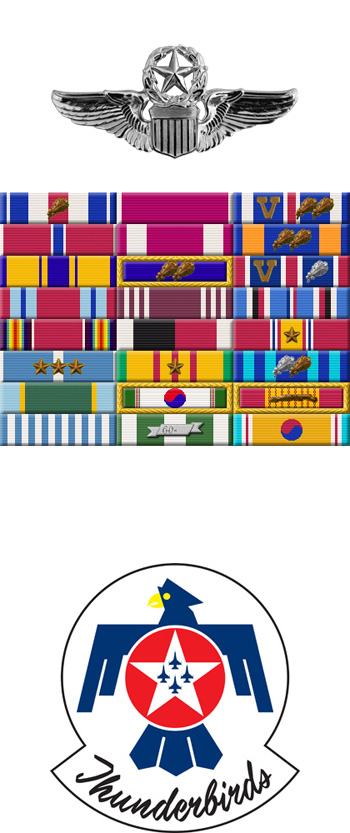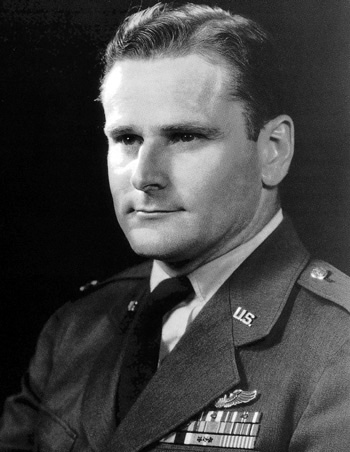
|
Ralph D. Gibson |
 |
|||
| Rank, Service | ||||
Colonel O-6, U.S. Air Force |
||||
| Veteran of: | ||||
|
||||
| Tribute: | ||||
Hoot Gibson was born on November 7, 1924, in Keensburg, Illinois. He enlisted in the Aviation Cadet Program of the U.S. Army Air Forces on June 10, 1943, and was warranted a Flight Officer and awarded his pilot wings at Aloe Field, Texas, on December 23, 1944. He remained in the U.S. during World War II, and was commissioned a 2d Lt on April 4, 1946. Gibson then joined the 40th Fighter Squadron of the 35th Fighter Group at Johnson AB, Japan, where he served from June 1946 to September 1948, followed by service with the 2469th AFRTC at Scott AFB, Illinois, from December 1948 to July 1949. After attending the Armament Officer Course, Capt Gibson served with the 63rd Fighter Interceptor Squadron (FIS) of the 56th Fighter Interceptor Group (FIG) at Selfridge AFB, Michigan, from March to November 1950, followed by a combat tour in Korea with the 335th FIS of the 4th FIG from November 1950 to October 1951. During this time, he flew 93 combat missions and was credited with the destruction of 5 enemy aircraft in aerial combat plus 2 probables and 3 damaged. Capt Gibson then returned to the 63rd FIS, where he served from October 1951 to January 1954, followed by service with the 22nd and 23rd Fighter-Bomber Squadron of the 36th Fighter-Bomber Wing at Bitburg AB, West Germany, from February 1954 to September 1957. He then served as Director of Academic Training with the 3525th Combat Crew Training Squadron at Nellis AFB, Nevada, from September 1957 to February 1958, followed by Director of Material and Director of Operations for the Fighter Weapons School at Nellis until June 1959. Col Gibson was commander of the 4521st Combat Crew Training Squadron at Nellis from June 1959 to April 1960, a staff officer with the 4520th Combat Crew Training Group from April to December 1960, and commander of the 4529th Organizational Maintenance Squadron from December 1960 to March 1961. Col Gibson next served as Commander of the 4520th Air Demonstration Squadron, the U.S. Air Force Thunderbirds, flying the F-100 Super Sabre from March 1961 to June 1963. His next assignment was as a staff officer with Headquarters U.S. Air Forces in Europe stationed in West Germany, from June 1963 to August 1966, followed by Air War College at Maxwell AFB, Alabama, from August 1966 to July 1967. He then completed F-4 Phantom II Combat Crew Training before serving as Commander of the 433rd Tactical Fighter Squadron at Ubon Royal Thai AFB, Thailand, from December 1967 to November 1968. During this time he flew 105 combat missions. His next assignment was as Deputy Commander for Operations of the 4453rd Combat Crew Training Wing at Davis-Monthan AFB, Arizona, from January 1969 to December 1970, followed by service as Chief of the Inspection Division with Headquarters Tactical Air Command at Langley AFB, Virginia, from January 1971 to October 1972. Col Gibson's final assignment was as Chief of Staff for Air Operations with 9th Air Force at Shaw AFB, South Carolina, where he served from October 1972 until his retirement from the Air Force on June 30, 1974. After his retirement, he formed Hoot Gibson Realty in Tucson, Arizona. Hoot Gibson died on January 2, 2009. He and his wife Donna have three children together-Scott, Duane, and Craig. Hoot was a member of the Red River Valley Fighter Pilots Association, the Air Force Association, and the American Fighter Aces Association. |
||||
|
||||

